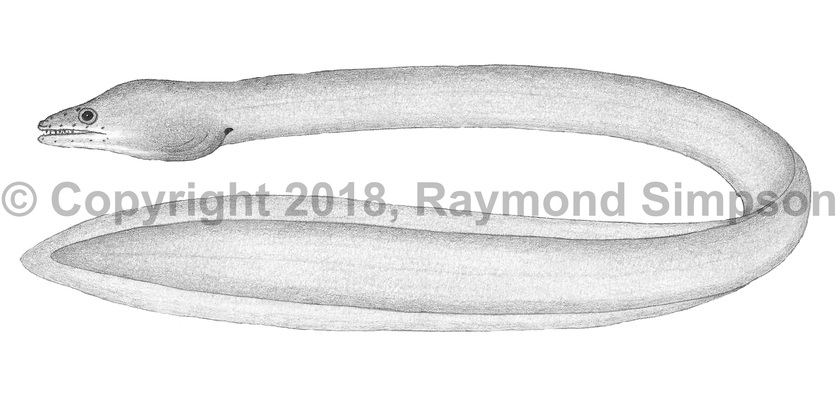
Common Name
Redface Moray
Year Described
Parr, 1930
Identification
Body small and elongate. Trunk a little shorter than tail. Head tapers anteriorly to blunt snout. Jaw closes completely. Multiple rows of fangs in upper jaw: an outer row of small outer teeth, an inner row of larger canines, and a median row of canines. Vomer with a row of teeth. Lower jaw with an outer row of small pointed teeth and an inner row of larger fangs. Anterior nostril is a small tube. Rear nostril an external opening above anterior margin or eye. Eye large. Throat region grooved. Gill opening a simple slit. Dorsal fin origin near level of anus. Dorsal and anals fins well developed. Fins confluent around tail. A single lateral pore on gill region (other morays have two).
Color
Body brilliant orange to brownish-orange with no markings. Head brighter in color. Belly is often whitish, as well as patches on the lower jaw and around upper jaw margin. Tail tip yellow.
Size
A small species reaching a maximum size of 21cm TL.
Habitat
Inhabits coral reefs and rocky areas from 13-45m.
Range
Scattered records from off the southeastern U.S., the Bahamas, the SE Gulf of Mexico, the Greater Antilles, the Lesser Antilles, and Trindade Island, Brazil. Appears to be widespread at insular localities into the Indo-Pacific.
References
Böhlke, E.B. 2002. Muraenidae (pp 700-718). In: Carpenter. 2002. The living marine resources of the Western Central Atlantic. Vol. 32: Bony fishes part 1 (Acipenseridae to Grammatidae). FAO Species Identification Guides for Fisheries Purposes. American Society of Ichthyologists and Herpetologists Special Publication No. 5.
Ross, S.W., Casazza, T.L., Quattrini, A.M., & K.J. Sulak. 2007. Anguilliform larvae collected off North Carolina. Marine Biology, 150(4), 681-695.
Simon, T., Macieira, R.M., & J.C. Joyeux. 2013. The shore fishes of the Trindade–Martin Vaz insular complex: an update. Journal of Fish Biology, 82(6), 2113-2127.
Other Notes
Color alone is enough to separate this species from other small morays and the juveniles of large species, but the position of the dorsal fin origin and the single lateral pore will confirm the identification.